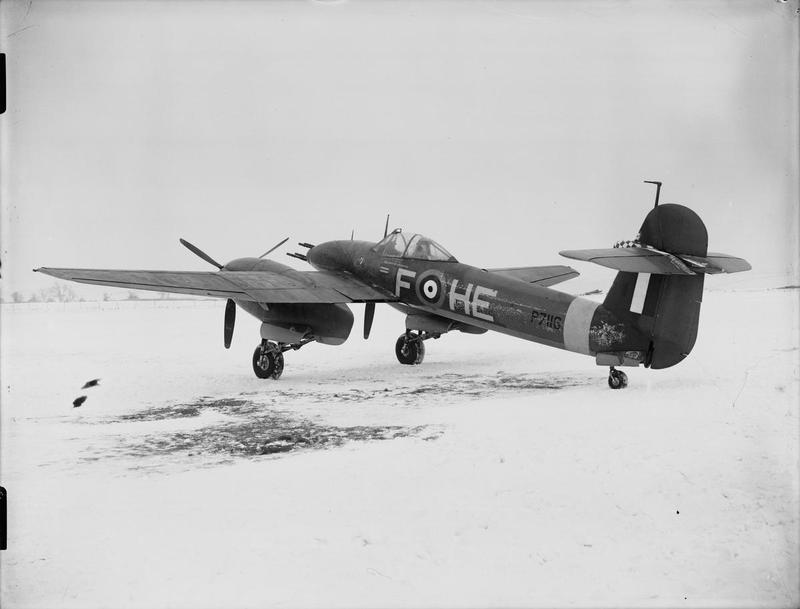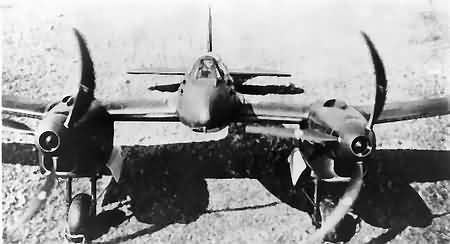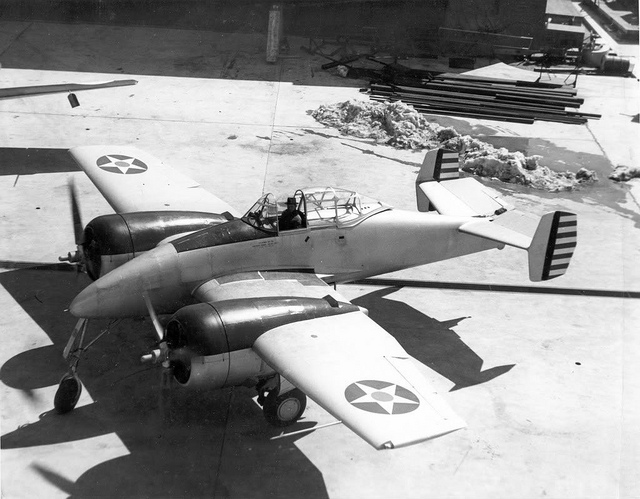Two pictures comparing the short and long nose Skyrockets. It's been suggested that the short nose's forward visibility was impeded by the wings leading edge thereby causing difficulties for carrier landings. And that lengthening the nose was a fix for this. But a close examination of the two different models would indicate otherwise. Notably the location of the cockpit which in both planes is just slightly forward of the wings trailing edge. Also the height of the cockpit is the same in both planes.
Actually the first is the original short-nose XF5F, the second is the long-nose XP-50 which is a re-design/re-build of the XF5F. This:
Is the "long-nose" XF5F note the 'slightly' different angles and viewing fields. Also note it is at this point still a "tail-dragger" landing gear set up.
The short-nose actually had a pretty good visibility for the higher angle "tail-dragger" landing but there was a problem with the aerodynamics of the short-nosed version DUE to the short-nose. So they put a longer nose on it as per the above in-flight picture but quickly found that once in the nose-high landing mode the pilot had difficulty seeing a stationary patch of marked runway simulating a carrier deck. (This was also an issue when moving around with a tail-dragger because you were ALWAYS 'nose-high' which could lead to running over people on deck, running off the side of the deck or even into that rack of bombs you didn't see sitting there because you litterally couldn't see it

) So they put the tricycle fear on it and faried the nose down to a point and rebuilt the cockpit.
So it appears there would be the same sight lines to the wing leading edges in both models. Going by these photos I think the short nose Skyrocket had the better forward visibility. In fact I would think it's the long nose version which would have had a reduced forward visibility. But with the sloping downward nose probably not too bad. Certainly far better then a F4U and maybe a little better than the F6F.
Yep, heck even the P-40 had issues with 'seeing' where you were going on the ground. And then there was the "Jug"

The main reasons for lengthening the nose were to improve aerodynamics to reduce drag and to allow the nose gear to be fitted for the tricycle landing gear. And add a bit more room for armaments.
IIRC also a slide slip and instability issue with the short nose when manuevering which the extended nose got rid of.
As I understand it the main difference between the long nose XF5F and the XP-50 was the XP-50s' Wright R-1820s were fitted with the same turbochargers that the B-17s' R1820s used as the AAF wanted better high altitude performance. The XF5Fs for the Navy used R-1820s fitted with the two-speed superchargers similar to the early F4Fs.
I can't actually 'see' it from the photo's but according to the texts I read they also actually moved the engine nacelles a bit backwards to improve the balance for the tricycle gear and pilot visibility.
@RanulfC That's an interesting take you have on a possible ATL use of the F5F and its variants. And I appreciate the link to Just Leos' thread about a turbocharged inline Continental engined version. It was a nice reminder of Just Leo and his talent for making excellent drawings of airplanes both real and imagined.
Thanks and yes

One point regarding the smaller squadron sizes. If the pilots flying the F5F, which I think had a performance similar to the F6F Hellcat, were to achieve near OTL F6F Hellcat kill ratios against the Japanese and also gain the benefit of enhanced survivability that having two engines brings then the smaller numbers are not as critical.
Basically producing the F5F would have been a practical way to equip U.S. Navy squadrons with a airplane that over matches the Japanese about one full year before the Hellcat starts entering squadron service. Also this doesn't prevent or delay the development and deployment of the F6F or the F4U. It prevents the deployment of the F4F Wildcat. It's not needed. I think the F5F could have been flown from escort carriers as a fighter and as a fighter bomber. Smaller numbers sure but packing a bigger punch.
Ok, I'll bring it up before McPherson does; Everything being equal that would be true but it's obviously NOT going to be equal because the US is seriously behind both in training and doctrine which will be a factor early on. OTL by the time the F6F came out (1942) we had had experience, (mostly bad but with a LOT of learning being done by the survivors) in fighting the Axis and it's those hard-earned lessons that allowed, along with the performance capability of the aircraft, to get those kill rates. Even with in some ways superior performance we're not going to see that early on and in fact the added performance will likely see higher losses due to overconfidence and lack of experiance.
Like OTL pilots will be trained to use the performance they have to make standard attacks on 'enemy' forces which in most cases means trying to engage in turning dogfights with more manuverable aircraft because that's what they are taught to do. And that means despite the superior performance of their aircraft the pilots are in a battle they initially can't win. They WILL learn, (we did OTL after all) but it's likely the obvious (on paper) superiority advantage is going to make those lessons more, not less difficult to learn. While I agree that it probably won't be as bad as having obviously inferior aircraft to work with also keep in mind that OTL that was in some cases an early wake up call vis-a-vis foreign use for "obsolete" aircraft versus clearly over-matching opponents which won't be the case TTL.
I think that the F5F can operate off escort carriers as well but it's a question of will they given the ability to 'pack' in larger numbers of smaller aircraft. Take the French and British for example. They bought the F4F OTL due to not having an available airframe of their own but still do they want to use something that's going to obviously be bigger and more complicated than the design they are aiming for or something that is more in line with the future capabillty they are already aiming for? Compare a Skyrocket to a Seafire for example, the former is a LOT different both operationally and performance wise than the latter and having to transition back and forth 'eventually' would likely mean on most basic level they will instead opt for something similar in nature to the upcoming Seafire rather than the Skyrocket. (No F4F probably means some different version of the F2A or maybe an Navalized version of the P-37 or P-40) I made the assumption that performance would actually trump over operations and economics but that's being pretty generous.
As pointed out where they can be used effectivly and where they aren't squandered by bad tactics, doctrine or training/over-confidence they will be a very rude shock. Zoom-and-boom, hit and run and keeping out of a turning fight with the enemy they are going to shine and tear things up. But there will be fewer of them as well which means they will be a thinner margine for error and forgiveness.
For example, using my 'logic' there would be only 6 F5F's on Wake Island (
https://www.ibiblio.org/hyperwar/USMC/USMC-C-Wake.html) prior to the attack. Kill 4 on the ground with two on air patrol means there are only two left. I'd see them doubling their bomber count OTL, (4 instead of 2 on the subsequent raid downed) but that's out of a total of 36 so still not at all decisive. Being generous again lets say those two still sink a destroyer on the first invasion attempt and one on the second and still kill the same number of airplanes etc. (And this assumes they aren't being 'attritted' slowly as the OTL F4Fs were dropping one by one over time, all being put out of action by December 21st OTL)
Absent the reliefe force pushing on despite understanding (only partially false data) there being at least two Japanese carriers (true) and a pair of fast battleships (false) plus escorts and transports against a single US carrier, (which was vitally important to operations in the Pacific) three cruisers and 10 destroyers. Arrival was calculated to be on December 23rd and the Japanes were already on the island as of the 22nd. Keep in mind that Saratoga was short on aircraft, (OTL 13 Wildcats, so call it 7 F5Fs) and the 'relief' Marine Air unit had only F2A's with no carrier experiance. Odds don't look good at all.
So until both experiance and numbers begin to show up significantly (early 1942-ish) the actual effect of the F5F is going to be minor at best. Once they do however the odds go against the Japanese exponentially.
Randy





